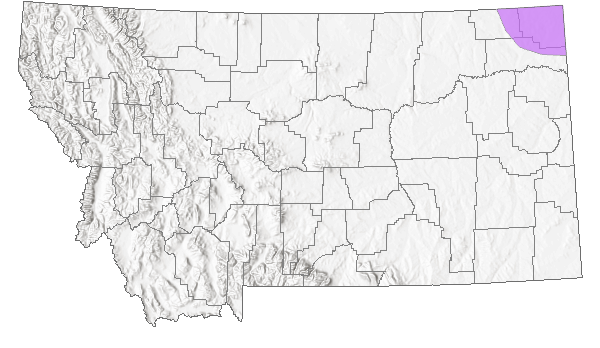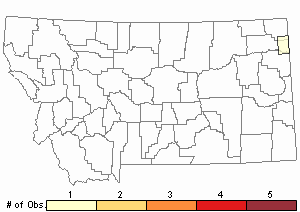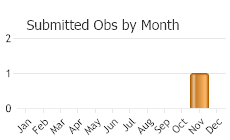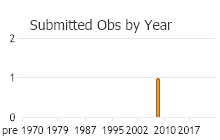View in other NatureServe Network Field Guides
NatureServe
Montana
Utah
Wyoming
Idaho
Wisconsin
British Columbia
South Carolina
Yukon
California
New York
Question Mark - Polygonia interrogationis
General Description
[From Ferris and Brown 1981; Scott 1986; Opler and Wright 1999; Glassberg 2001] Forewing 2.4-3.5 cm. Large. Uppersurface forewing, margin quite hooked, with "extra" black subapical horizontal bar (in cell M2), hindwing margin often with violet tones, largely black with short tail projections in summer form, orange and black with longer violet-tipped tail projections in winter form; undersurface brown with variable markings, a silver and stylized question mark (or two-part broken comma) on hindwing.
Phenology
Two flights in the north, mid-June to early August, late August overwintering to May; three (or four) flights in the south, May to June, July, September overwintering to April (Scott 1986). In Colorado, June to early July and late July to late August overwintering to April or May (Scott and Scott 1978).
Diagnostic Characteristics
Best determined by a combination of large size, the "extra" black subapical horizontal bar (in cell M2) on the uppersurface of forewing, undersurface brown with variable markings, a silver and stylized question mark (or two-part broken comma) on hindwing.
Species Range
Montana Range
Range Descriptions

 Native
Native
Range Comments
Across extreme southern Canada from southeastern Saskatchewan to Nova Scotia and New Brunswick, south in the east throughout the eastern US to the gulf states, in the west through the Dakotas , eastern Colorado, and New Mexico to southeastern Arizona and central Mexico, (Opler and Wright 1999; Glassberg 2001); to 1765 m elevation in Colorado (Brown 1957; Scott and Scott 1978). In Montana, not reported prior to 1993 (Kohler 1980; Stanford and Opler 1993); documented at Medicine Lake National Wildlife Refuge, Sheridan County in July 2008 (FLMNH Lepidopterists' Society database). Uncommon to common in Texas north to Oklahoma and Colorado, rare to uncommon elsewhere in the west (Glassberg 2001).
Observations in Montana Natural Heritage Program Database
Number of Observations: 1
(Click on the following maps and charts to see full sized version)
Map Help and Descriptions
Relative Density

Recency



 (Observations spanning multiple months or years are excluded from time charts)
(Observations spanning multiple months or years are excluded from time charts)
Migration
Semi-migratory; small migrations in some regions (Scott 1986).
Habitat
Riparian woodlands, wooded swamps, city parks, wet woodland openings, orchards (Feris and Brown 1981; Scott 1986; Opler and Wright 1999; Glassberg 2001). Habitat in Montana not described, but likely similar (prairie wooded wetlands).
Food Habits
Larval food plants include Boehmeria, Celtis, Humulus, Ulmus (several species), and Urtica (Ferris and Brown 1981; Scott 1986, 1992, 2006). Adults feed on flower nectar (including Asclepias, Chrysothamnus, Crataegus, Monarda, Neptia, Silphium, Tilia) but most often on rotting fruit, sap, mud, and carrion (Reed 1958; Scott and Scott 1978; Scott 1986, 2014; Tooker et al. 2002).
Reproductive Characteristics
Females lay eggs singly (sometimes stacked in a pile up to 8 eggs) on the undersides of young host plant leaves. Larvae tend to be solitary but may live with a few other individuals on undersides of leaves, seldom make nests (with leaf edges drawn down if nest built); overwinters (hibernates) as adult (Scott 1979, 1986; Ferris and Brown 1981). Males seemingly territorial, patrol particular areas near trees in open fields while alert for passing females (Hendricks 1974), or perch on tree trunks or leaves to await appearance of females (Scott 1986).
Stewardship Responsibility
References
- Literature Cited AboveLegend:
 View Online Publication
View Online Publication Brown, F.M. 1957. Colorado Butterflies. Proceedings; Numbers Three through Seven. Denver Museum of Natural History, Denver, Co.
Brown, F.M. 1957. Colorado Butterflies. Proceedings; Numbers Three through Seven. Denver Museum of Natural History, Denver, Co. Ferris, C.D. and F.M. Brown (eds). 1981. Butterflies of the Rocky Mountains. Univ. of Oklahoma Press. Norman. 442 pp.
Ferris, C.D. and F.M. Brown (eds). 1981. Butterflies of the Rocky Mountains. Univ. of Oklahoma Press. Norman. 442 pp. Glassberg, J. 2001. Butterflies through Binoculars: A Field Guide to the Butterflies of Western North America. Oxford University Press.
Glassberg, J. 2001. Butterflies through Binoculars: A Field Guide to the Butterflies of Western North America. Oxford University Press. Hendricks, D.P. 1974. 'Attacks' by Polygonia interrogationis (Nymphalidae) on Chimney Swifts and insects. Journal of the Lepidopterists' Society 23: 236.
Hendricks, D.P. 1974. 'Attacks' by Polygonia interrogationis (Nymphalidae) on Chimney Swifts and insects. Journal of the Lepidopterists' Society 23: 236. Kohler, S. 1980. Checklist of Montana Butterflies (Rhopalocera). Journal of the Lepidopterists' Society 34(1): 1-19.
Kohler, S. 1980. Checklist of Montana Butterflies (Rhopalocera). Journal of the Lepidopterists' Society 34(1): 1-19. Opler, P.A. and A.B. Wright. 1999. A field guide to western butterflies. Second edition. Peterson Field Guides. Houghton Mifflin Company, Boston, Massachusetts. 540 pp.
Opler, P.A. and A.B. Wright. 1999. A field guide to western butterflies. Second edition. Peterson Field Guides. Houghton Mifflin Company, Boston, Massachusetts. 540 pp. Reed, H.B., Jr. 1958. A study of dog carcass communities in Tennessee, with special reference to the insects. American Midland Naturalist 59(1): 213-245.
Reed, H.B., Jr. 1958. A study of dog carcass communities in Tennessee, with special reference to the insects. American Midland Naturalist 59(1): 213-245. Scott, J.A. 1979. Hibernal diapause of North American Papilionoidea and Hesperioidea. Journal of Research on the Lepidoptera 18(3): 171-200.
Scott, J.A. 1979. Hibernal diapause of North American Papilionoidea and Hesperioidea. Journal of Research on the Lepidoptera 18(3): 171-200. Scott, J.A. 1986. The butterflies of North America: a natural history and field guide. Stanford University Press, Stanford, California.
Scott, J.A. 1986. The butterflies of North America: a natural history and field guide. Stanford University Press, Stanford, California. Scott, J.A. 1992. Hostplant records for butterflies and skippers (mostly from Colorado) 1959-1992, with new life histories and notes on oviposition, immatures, and ecology. Papilio new series #6. 185 p.
Scott, J.A. 1992. Hostplant records for butterflies and skippers (mostly from Colorado) 1959-1992, with new life histories and notes on oviposition, immatures, and ecology. Papilio new series #6. 185 p. Scott, J.A. 2006. Butterfly hostplant records, 1992-2005, with a treatise on the evolution of Erynnis, and a note on new terminology for mate-locating behavior. Papilio new series #14. 74 p.
Scott, J.A. 2006. Butterfly hostplant records, 1992-2005, with a treatise on the evolution of Erynnis, and a note on new terminology for mate-locating behavior. Papilio new series #14. 74 p. Scott, J.A. 2014. Lepidoptera of North America 13. Flower visitation by Colorado butterflies (40,615 records) with a review of the literature on pollination of Colorado plants and butterfly attraction (Lepidoptera: Hersperioidea and Papilionoidea). Contributions of the C.P. Gillette Museum of Arthopod Diversity. Fort Collins, CO: Colorado State University. 190 p.
Scott, J.A. 2014. Lepidoptera of North America 13. Flower visitation by Colorado butterflies (40,615 records) with a review of the literature on pollination of Colorado plants and butterfly attraction (Lepidoptera: Hersperioidea and Papilionoidea). Contributions of the C.P. Gillette Museum of Arthopod Diversity. Fort Collins, CO: Colorado State University. 190 p. Scott, J.A. and G.R. Scott. 1978. Ecology and distribution of the butterflies of southern central Colorado. Journal of Research on the Lepidoptera 17(2): 73-128.
Scott, J.A. and G.R. Scott. 1978. Ecology and distribution of the butterflies of southern central Colorado. Journal of Research on the Lepidoptera 17(2): 73-128. Stanford, R.E. and P.A. Opler. 1993. Atlas of western USA butterflies: including adjacent parts of Canada and Mexico. Unpubl. Report. Denver and Fort Collins, Colorado 275 pp.
Stanford, R.E. and P.A. Opler. 1993. Atlas of western USA butterflies: including adjacent parts of Canada and Mexico. Unpubl. Report. Denver and Fort Collins, Colorado 275 pp.
- Additional ReferencesLegend:
 View Online Publication
View Online Publication
Do you know of a citation we're missing? Allen, T.J., J.P. Brock, and J. Glassberg. 2005. Caterpillars in the field and garden: a field guide to the butterfly caterpillars of North America. Oxford University Press.
Allen, T.J., J.P. Brock, and J. Glassberg. 2005. Caterpillars in the field and garden: a field guide to the butterfly caterpillars of North America. Oxford University Press. Brock, J.P. and K. Kaufman. 2003. Kaufman Field Guide to Butterflies of North America. Houghton Mifflin Company, New York, NY 284 pp.
Brock, J.P. and K. Kaufman. 2003. Kaufman Field Guide to Butterflies of North America. Houghton Mifflin Company, New York, NY 284 pp. Forister, M.L., E.M. Grames, C.A. Halsch, K.J. Burls, C.F. Carroll, K.L. Bell, J.P. Jahner, et al. 2023. Assessing risk for butterflies in the context of climate change, demographic uncertainty, and heterogeneous data sources. Ecological Monographs 93(3):e1584. https://doi.org/10.1002/ecm.1584
Forister, M.L., E.M. Grames, C.A. Halsch, K.J. Burls, C.F. Carroll, K.L. Bell, J.P. Jahner, et al. 2023. Assessing risk for butterflies in the context of climate change, demographic uncertainty, and heterogeneous data sources. Ecological Monographs 93(3):e1584. https://doi.org/10.1002/ecm.1584 Layberry, R.A., P.W. Hall, and J.D. LaFontaine. 1998. The Butterflies of Canada. University of Toronto Press. 280 pp. + color plates.
Layberry, R.A., P.W. Hall, and J.D. LaFontaine. 1998. The Butterflies of Canada. University of Toronto Press. 280 pp. + color plates.
- Web Search Engines for Articles on "Question Mark"
- Additional Sources of Information Related to "Insects"





